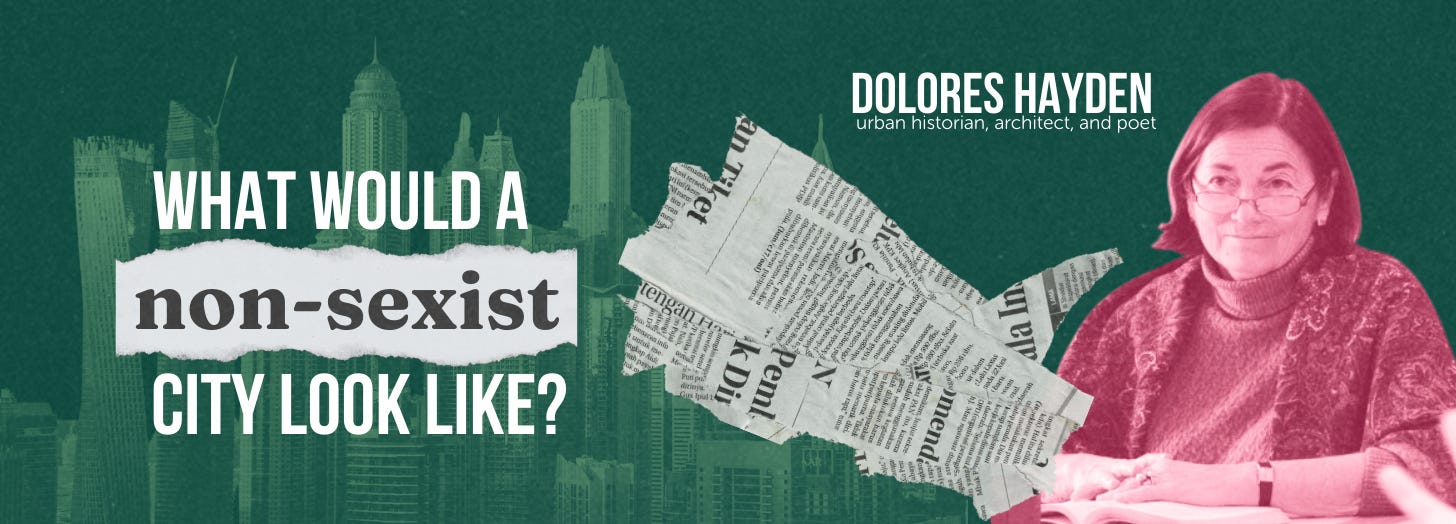what would a non-sexist city look like?
Dolores Hayden’s 1980 essay ‘What Would a Non-Sexist City Look Like?’ challenged how gender roles are baked into city design. Decades later, women are still being left behind.
💬 What Would a Non-Sexist City Look Like?
Dolores Hayden’s 1980 essay ‘What Would a Non-Sexist City Look Like?’ challenged how gender roles are baked into city design. She argued that urban systems were historically designed with the traditional ‘male-breadwinner, female-homemaker’ model in mind. While originally published four decades ago, Hayden’s insights remain relevant today.
Public transit systems often study ridership as a whole, which fails to account for the experience of female riders. “When data doesn’t consider women specifically, we tend to have white men as the default in a lot of our systems,” explained Priyanka Babbar, a master’s student at the University of Alberta’s School of Urban and Regional Planning (Babbar et al., 2022).
Despite their reliance on public transit, women frequently encounter disproportionate safety risks and accessibility challenges. Women-dominated fields such as healthcare, retail, and education often require non-traditional work hours, meaning many women commute during off-peak times when transit service is infrequent, leaving them more vulnerable to safety concerns (Babbar et al., 2022). However, travelling during rush hour isn’t safer as overcrowded buses and train cars have also been linked to higher instances of sexual violence (Zhen, 2021).
Women are more likely to experience harassment on public transportation than men. In New York City, for example, women disproportionately experience subway-based crimes, including robbery and physical or sexual harassment (Fitzsimmons, 2016). Joseph Fox, the chief of the New York City Transit Bureau, stated: “Many men don’t know this issue exists; far too many women do” (Fitzsimmons, 2016).
Simply looking at ridership as a whole can leave behind vulnerable groups, reinforcing existing inequalities. These challenges cannot be addressed without systemic policy changes that prioritize women's safety and participation in transportation decision-making
Women must be included not only as passengers but also as leaders, decision-makers, and employees within the transportation sector to ensure services are designed to meet their needs.
Public transportation must be equitable, fair, and accessible because moving safely and with dignity is a right, not a privilege. This International Women’s Day, let’s advocate for greater investment in public transportation infrastructure. Because at its core, overcrowded trains and underfunded transit systems aren’t just comfort issues, they’re safety issues.
Enjoyed this thinkpiece? Support what we do!
Please support our work by becoming a BEST member! We’re grateful to our members and supporters whose generous donations help sustain our activities. If you want to continue supporting active and sustainable transportation initiatives in British Columbia, consider becoming a BEST Member.
Members receive first access to our events AND a FREE one-month membership to Mobi!
References:
Babbar, P., Peace, J., Cooper, D., Boisjoly, G., & Grisé, E. (2022). Understanding and responding to the transit needs of women in Canada. [Report]. Polytechnique Montréal. https://publications.polymtl.ca/10017/
Fitzsimmons, E. G. (2016, February 22). Subway sex crimes increase as police urge women to come forward. The New York Times. https://www.nytimes.com/2016/02/23/nyregion/subway-sex-crimes-increase-as-police-urge-women-to-come-forward.html
Hayden, D. (1980). What would a non-sexist city be like? Speculations on housing, urban design, and human work. Signs: Journal of Women in Culture and Society, 5(3), S170–S187. https://doi.org/10.1086/493733
Macpherson, A. (2022). Public transit services in Canadian cities not meeting many women's travel needs. Folio. University of Alberta. https://www.ualberta.ca/en/folio/2022/01/public-transit-services-in-canadian-cities-not-meeting-many-womens-travel-needs.html#:~:text=the%20day
UITP (International Association of Public Transport). (2022). 10 statistics of women in transport that show why public transport matters. https://www.uitp.org/news/10-statistics-of-women-in-transport-that-show-why-public-transport-matters/
Zhen, S. (2021, March). Rethinking public transportation for women’s safety and security. ICLEI - Local Governments for Sustainability. https://sustainablemobility.iclei.org/rethinking-public-transportation-for-womens-safety-and-security/





